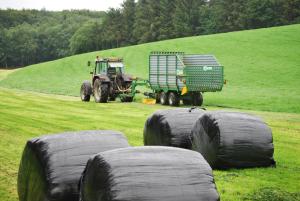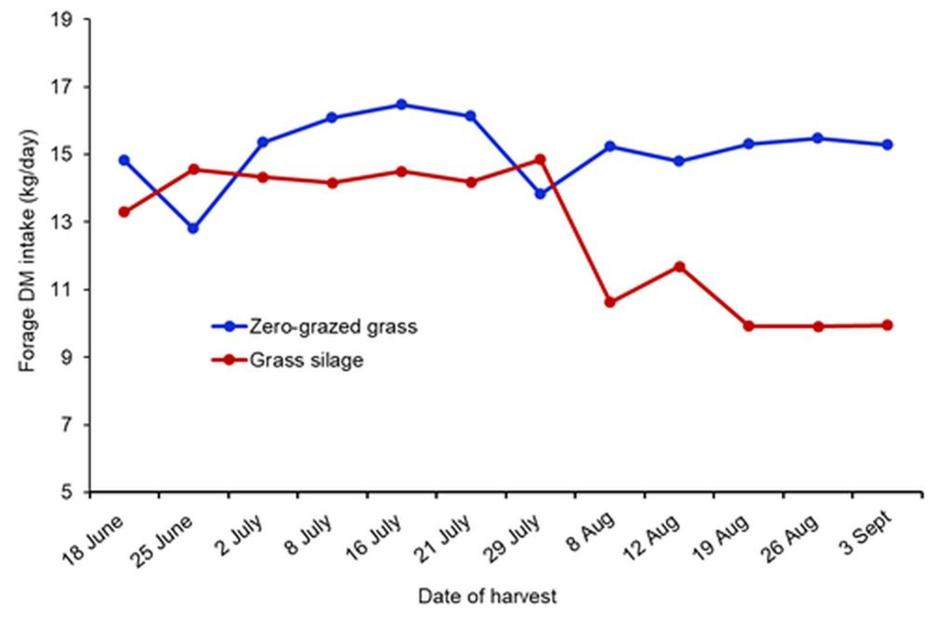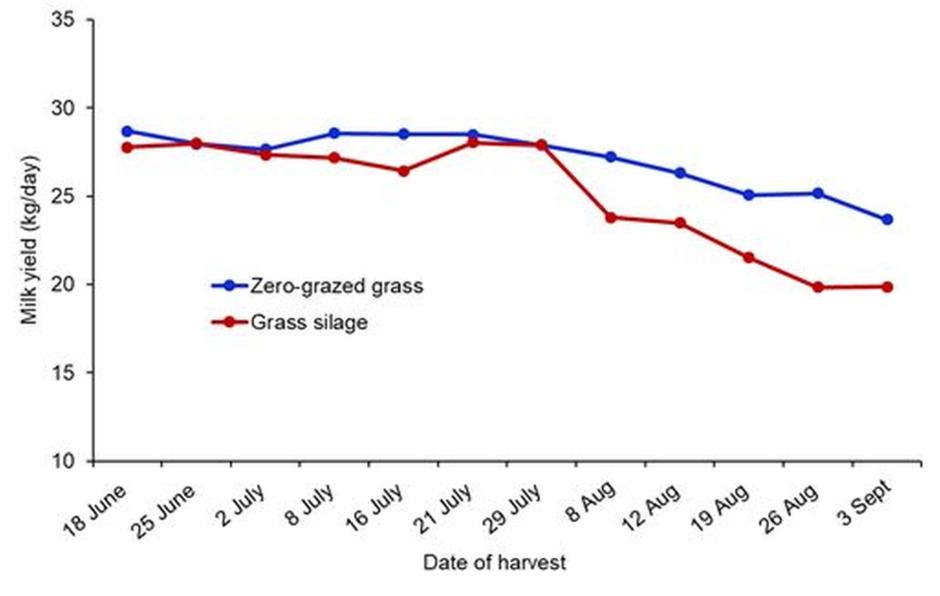Zero-grazed grass, or grass silage produced from herbage at the same growth stage, for indoor feeding over the summer?
Date published:
Systems in which dairy cows are housed during the summer, either full-time or part-time, are now common on many farms.

Background
The reasons for summer housing are many, and include expanding herd sizes, fragmented farms, and the ability to better manage the nutrition of high yielding dairy cows. While herds housed during the summer are normally offered grass silage, the nutritive value of silage offered is normally lower than that of grazed grass. As a result, some farmers have adopted zero-grazing to improve the quality of the forage being offered. Indeed, previous AFBI research has shown improved performance with cows offered zero-grazed grass compared to grass silage.
Zero-grazing can however be labour intensive, requiring either daily or twice daily harvesting of fresh herbage. In addition, it can be difficult to maintain a sward at the optimum quality for zero-grazing throughout the season. Thus the question, how would cows perform if offered silage produced from a sward at the same stage of growth as is normally harvested for zero-grazing? Offering very high quality silage (rather than zero-grazing) would have a number of possible advantages, including reducing the need for harvesting to approximately once every 4 – 5 weeks (rather than daily), while making it easier to harvest the sward at the optimum growth stage. However, silage production (unlike zero-grazing) is weather dependent, and ensiling young leafy herbage can be challenging, especially later in the season. The current study, which was co-funded by DAERA and AgriSearch, was designed to answer this question.
The study
While it was planned that the study would be conducted over the entire growing season, the start date was delayed by Covid restrictions in spring 2020. The study was subsequently conducted over a 12-week period between June and September 2020. Fresh grass for zero-grazing was cut daily and offered to a group of 18 mid lactation dairy cows. Grass for silage production was cut once per week, from the same sward where zero-grazing took place. Weather permitting, grass was tedded to facilitate wilting, with a target dry matter at ensiling of 25 – 30%. Grass was ensiled in round bales with no additive applied at ensiling. Following a 5-week storage period, silage was offered to a second similar group of 18 cows for 12 weeks. Cows in both groups were offered 8 kg concentrate per day via an out-of-parlour feeding system.
Outcomes
Composition of the zero-grazed grass and grass silage
The chemical composition of the zero-grazed grass and grass silage offered is presented in Table 1. The zero-grazed grass had an average DM content of 15.6 % (range, 11.1 to 22.7% DM) while the grass silage had an average DM content of 27.3 % (range, 16.8 to 38.1% DM). The silage had a slightly lower crude protein content than the zero-grazed grass, reflecting loss of protein during ensilage. However, both forages had a similar metabolisable energy and fibre content, indicating that both were harvested at a similar stage of maturity.
Zero-grazing can however be labour intensive, requiring either daily or twice daily harvesting of fresh herbage. In addition, it can be difficult to maintain a sward at the optimum quality for zero-grazing throughout the season. Thus the question, how would cows perform if offered silage produced from a sward at the same stage of growth as is normally harvested for zero-grazing? Offering very high quality silage (rather than zero-grazing) would have a number of possible advantages, including reducing the need for harvesting to approximately once every 4 – 5 weeks (rather than daily), while making it easier to harvest the sward at the optimum growth stage. However, silage production (unlike zero-grazing) is weather dependent, and ensiling young leafy herbage can be challenging, especially later in the season. The current study, which was co-funded by DAERA and AgriSearch, was designed to answer this question.
Table 1. Average composition of the zero-grazed grass and grass silage offered during the study
| Zero-grazed grass | Grass Silage | |
| Dry matter (%) | 15.6 | 27.3 |
| Crude protein (% DM) | 15.7 | 14.3 |
| Metabolisable energy (MJ/kg DM) | 11.0 | 11.3 |
| Fibre (% DM) | 50.5 | 47.6 |
| pH | - | 4.1 |
| Ammonia (% total nitrogen) | - | 6.8 |
| Lactic acid (% DM) | - | 7.8 |
Impact on cow performance
Intakes of zero-grazed grass were higher than intakes of grass silage (Table 2), with intakes of silage produced between 30 July to 3 September being especially low (Figure 1), reflecting the challenges of ensiling leafy herbage later in the season. Milk yields followed a similar trend to silage intakes, being relatively unaffected between treatments earlier in the season, but then decreasing more rapidly with the silage treatment later in the season (Figure 2).


| Zero-grazed grass | Grass Silage | |
| Forage DM intake (kg/day) | 15.1 | 12.7 |
| Concentrate DM intake (kg/day) | 7.1 | 7.0 |
| Toptal DM intake (kg/day) | 22.2 | 25.1 |
| Milk yield (kg/day) | 27.1 | 25.1 |
| Fat content (%) | 4.50 | 4.47 |
| Protein content (%) | 3.72 | 3.45 |
| Fat + protein yield (kg/day) | 2.23 | 1.96 |
| Types of fat in milk (% of total fat) | ||
| Saturated fats | 67.9 | 73.1 |
| Mono-unsaturated fats | 25.3 | 21.9 |
| Poly-unsaturated fats | 2.8 | 2.1 |
| Conjugated linoleic acid | 1.24 | 0.87 |
Practical implications
Cows offered zero-grazed grass had higher forage DM intakes, milk yields, milk fat plus protein yields, and a higher milk protein content compared to those offered grass silage prepared from the same sward. In addition, these cows produced milk containing ‘healthier’ fats. The differences in intakes and milk yields were particularly apparent later in the season (August and September), which is likely to reflect challenges of ensiling herbage at this time. Performance aside, both systems have their challenges: zero-grazing can be labour intensive, and it can also be a challenge to ensure a daily supply of grass at the optimum nutritive value throughout the summer. While silage production can be less labour intensive as large quantities of grass can be ensiled on a single day, and day-to-day variation in dry matter and nutritive value can be reduced, young leafy grass requires an adequate period of field wilting if it is to ferment properly. While weekly silage production was adopted in this study to ensure that herbage used for zero-grazing and for silage had a very similar composition, in practice on a farm, silage would be harvested once every 4 – 5 weeks.
Conclusion
Given the current cost of fuel and concentrate feeds, optimising the inclusion of grazed grass in dairy cow diets offers the lowest cost strategy by which to produce milk. Indeed, many local farmers continue to demonstrate that well managed grazing systems can sustain high levels of both physical and economic performance. Nevertheless, for many reasons, systems with a major focus on grazing are no longer practiced on many farms. In these situations the current study has demonstrated that offering zero-grazed grass increased forage DM intakes, milk yield and milk fat + protein yield, compared to grass silage prepared from the same sward at the same growth stage.
Notes to editors:
AFBI is an arms-length body of DAERA delivering research and development, diagnostic and analytical testing, emergency response capability and expert scientific advice for DAERA and other government departments, public bodies and commercial companies in Northern Ireland, and further afield.AFBI’s Vision is “Advancing the Local and Global Agri-Food Sectors Through Scientific Excellence”.AFBI’s core areas:Leading improvements in the agri-food industry;Protecting animal, plant and human health;Enhancing the natural and marine environment.